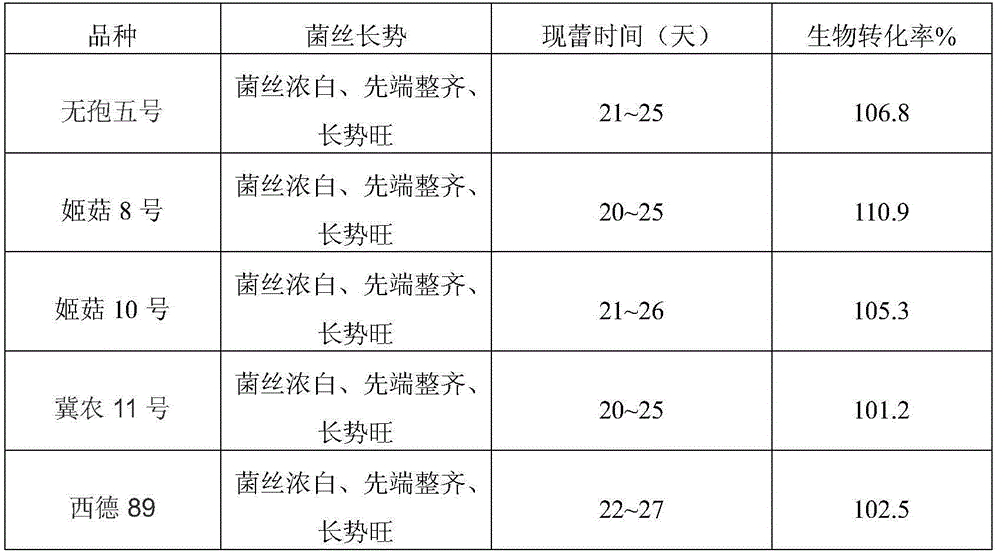Pleurotus cornucopiae cultivation material utilizing garlic straws and method for producing pleurotus cornucopiae by utilizing garlic straws as cultivation materials
A technology of garlic stalks and cultivation materials, which is applied in the field of agricultural microorganisms, can solve problems such as environmental pollution and low-efficiency utilization of garlic stalks, and achieve the effects of solving environmental pollution problems, significant environmental and economic benefits, and reducing costs
- Summary
- Abstract
- Description
- Claims
- Application Information
AI Technical Summary
Problems solved by technology
Method used
Image
Examples
Embodiment 1
[0040] A planting material for mushrooms using garlic stalks, which is prepared from the following raw materials in parts by weight:
[0041] 40 parts of crushed garlic straw, 40 parts of cottonseed husk, 13 parts of wheat bran, 2 parts of soybean powder, 1 part of superphosphate, 1 part of lime powder, 1 part of gypsum powder, 1 part of sugar, 0.1 part of magnesium sulfate, dihydrogen phosphate Potassium 0.2 parts.
[0042] The method for producing shimeji mushrooms by using garlic stalks as a cultivation material comprises the following steps:
[0043](1) Take garlic stalks without mildew and rot, dry them until the water content of the stalks is 16wt%, and then crush them to a particle size of 5 mm to obtain crushed garlic stalks; The straw part on the ground;
[0044] (2) Take the crushed garlic stalks prepared in step (1) and cottonseed husks and wheat bran, mix and stir evenly to make a mixture; the moisture content of the cottonseed husks is less than or equal to 15%,...
Embodiment 2
[0050] A planting material for mushrooms using garlic stalks, which is prepared from the following raw materials in parts by weight:
[0051] 35 parts of crushed garlic straw, 45 parts of cottonseed husk, 13 parts of wheat bran, 2 parts of soybean powder, 1 part of superphosphate, 1 part of lime powder, 1 part of gypsum powder, 1 part of sugar, 0.1 part of magnesium sulfate, dihydrogen phosphate Potassium 0.2 parts.
[0052] The method for producing shimeji mushrooms by using garlic stalks as a cultivation material comprises the following steps:
[0053] (1) Take garlic stalks without mildew and rot, dry them in the sun until the water content of the stalks is 17wt%, and then pulverize them with a particle size of 6 mm to obtain crushed garlic stalks; The straw part on the ground;
[0054] (2) Take the crushed garlic stalks prepared in step (1) and cottonseed husks and wheat bran, mix and stir evenly to make a mixture; the moisture content of the cottonseed husks is less tha...
Embodiment 3
[0060] A planting material for mushrooms using garlic stalks, which is prepared from the following raw materials in parts by weight:
[0061] 45 parts of crushed garlic straw, 35 parts of cottonseed husk, 13 parts of wheat bran, 2 parts of soybean powder, 1 part of superphosphate, 1 part of lime powder, 1 part of gypsum powder, 1 part of sugar, 0.1 part of magnesium sulfate, dihydrogen phosphate Potassium 0.2 parts.
[0062] The method for producing shimeji mushrooms by using garlic stalks as a cultivation material comprises the following steps:
[0063] (1) Take garlic stalks without mildew and rot, dry them until the moisture content of the stalks is 18wt%, and then crush them to a particle size of 5.5 mm to obtain crushed garlic stalks; the garlic stalks are obtained after the garlic heads are removed The aboveground straw part;
[0064] (2) Take the crushed garlic stalks prepared in step (1) and cottonseed husks and wheat bran, mix and stir evenly to make a mixture; the ...
PUM
 Login to View More
Login to View More Abstract
Description
Claims
Application Information
 Login to View More
Login to View More - R&D
- Intellectual Property
- Life Sciences
- Materials
- Tech Scout
- Unparalleled Data Quality
- Higher Quality Content
- 60% Fewer Hallucinations
Browse by: Latest US Patents, China's latest patents, Technical Efficacy Thesaurus, Application Domain, Technology Topic, Popular Technical Reports.
© 2025 PatSnap. All rights reserved.Legal|Privacy policy|Modern Slavery Act Transparency Statement|Sitemap|About US| Contact US: help@patsnap.com



